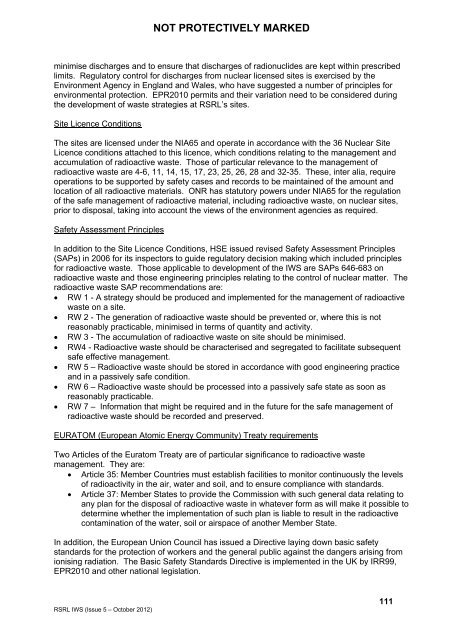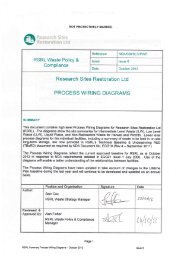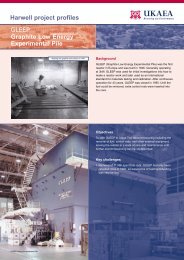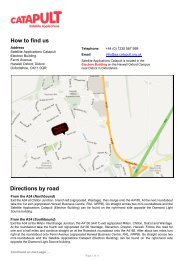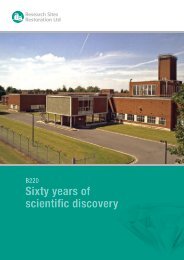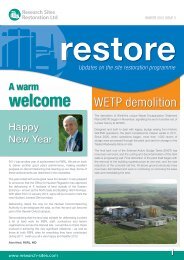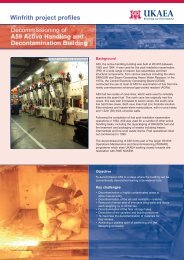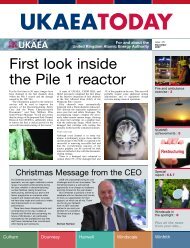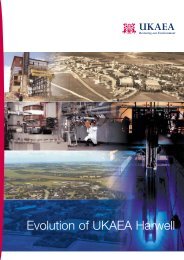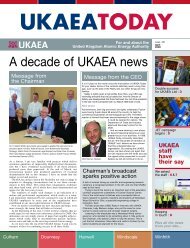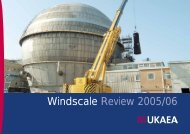RSRL Integrated Waste Strategy - Issue 5- Oct 2012.pdf
RSRL Integrated Waste Strategy - Issue 5- Oct 2012.pdf
RSRL Integrated Waste Strategy - Issue 5- Oct 2012.pdf
You also want an ePaper? Increase the reach of your titles
YUMPU automatically turns print PDFs into web optimized ePapers that Google loves.
NOT PROTECTIVELY MARKEDminimise discharges and to ensure that discharges of radionuclides are kept within prescribedlimits. Regulatory control for discharges from nuclear licensed sites is exercised by theEnvironment Agency in England and Wales, who have suggested a number of principles forenvironmental protection. EPR2010 permits and their variation need to be considered duringthe development of waste strategies at <strong>RSRL</strong>’s sites.Site Licence ConditionsThe sites are licensed under the NIA65 and operate in accordance with the 36 Nuclear SiteLicence conditions attached to this licence, which conditions relating to the management andaccumulation of radioactive waste. Those of particular relevance to the management ofradioactive waste are 4-6, 11, 14, 15, 17, 23, 25, 26, 28 and 32-35. These, inter alia, requireoperations to be supported by safety cases and records to be maintained of the amount andlocation of all radioactive materials. ONR has statutory powers under NIA65 for the regulationof the safe management of radioactive material, including radioactive waste, on nuclear sites,prior to disposal, taking into account the views of the environment agencies as required.Safety Assessment PrinciplesIn addition to the Site Licence Conditions, HSE issued revised Safety Assessment Principles(SAPs) in 2006 for its inspectors to guide regulatory decision making which included principlesfor radioactive waste. Those applicable to development of the IWS are SAPs 646-683 onradioactive waste and those engineering principles relating to the control of nuclear matter. Theradioactive waste SAP recommendations are:• RW 1 - A strategy should be produced and implemented for the management of radioactivewaste on a site.• RW 2 - The generation of radioactive waste should be prevented or, where this is notreasonably practicable, minimised in terms of quantity and activity.• RW 3 - The accumulation of radioactive waste on site should be minimised.• RW4 - Radioactive waste should be characterised and segregated to facilitate subsequentsafe effective management.• RW 5 – Radioactive waste should be stored in accordance with good engineering practiceand in a passively safe condition.• RW 6 – Radioactive waste should be processed into a passively safe state as soon asreasonably practicable.• RW 7 – Information that might be required and in the future for the safe management ofradioactive waste should be recorded and preserved.EURATOM (European Atomic Energy Community) Treaty requirementsTwo Articles of the Euratom Treaty are of particular significance to radioactive wastemanagement. They are:• Article 35: Member Countries must establish facilities to monitor continuously the levelsof radioactivity in the air, water and soil, and to ensure compliance with standards.• Article 37: Member States to provide the Commission with such general data relating toany plan for the disposal of radioactive waste in whatever form as will make it possible todetermine whether the implementation of such plan is liable to result in the radioactivecontamination of the water, soil or airspace of another Member State.In addition, the European Union Council has issued a Directive laying down basic safetystandards for the protection of workers and the general public against the dangers arising fromionising radiation. The Basic Safety Standards Directive is implemented in the UK by IRR99,EPR2010 and other national legislation.<strong>RSRL</strong> IWS (<strong>Issue</strong> 5 – <strong>Oct</strong>ober 2012)111


